Bio 256 exam 3 - Study guides, Class notes & Summaries
Looking for the best study guides, study notes and summaries about Bio 256 exam 3? On this page you'll find 49 study documents about Bio 256 exam 3.
Page 3 out of 49 results
Sort by
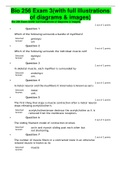
-
Bio 256 Exam 3(with full illustrations of diagrams & images) BEST GRADED Bio 256 Exam 3(with full illustrations of diagrams & images) BEST GRADED Bio 256 Exam 3(with full illustrations of diagrams & images) BEST GRADED Bio 256 Exam 3(with full illustratio
- Exam (elaborations) • 39 pages • 2023
-
- $10.49
- + learn more
Bio 256 Exam 3(with full illustrations of diagrams & images) BEST GRADED Bio 256 Exam 3(with full illustrations of diagrams & images) BEST GRADED Bio 256 Exam 3(with full illustrations of diagrams & images) BEST GRADED Bio 256 Exam 3(with full illustrations of diagrams & images) BEST GRADED Bio 256 Exam 3(with full illustrations of diagrams & images) BEST GRADED Bio 256 Exam 3(with full illustrations of diagrams & images) BEST GRADED Bio 256 Exam 3(with full illustrations of diagrams & ima...
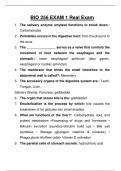
-
BIO 256 EXAM 1 Real Exam 2023
- Exam (elaborations) • 15 pages • 2023
-
- $10.99
- + learn more
BIO 256 EXAM 1 Real Exam 1. The salivary enzyme amylase functions to break down.: Carbohydrates 2. Peristalsis occurs in the digestive tract: from the pharynx to the anus 3. The ________________ serves as a valve that controls the movement of food between the esophagus and the stomach.: lower esophageal sphincter (also gastroesophageal or cardiac sphincter) 4. The membrane that binds the small intestines to the abdominal wall is called?: Mesentery 5. The accessory organs of the...
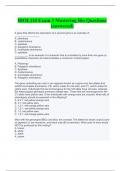
-
BIOL110 Exam 3 Mastering Bio Questions (answered)
- Exam (elaborations) • 31 pages • 2024
-
- $15.98
- + learn more
BIOL110 Exam 3 Mastering Bio Questions (answered) A gene that affects the expression of a second gene is an example of __________________. A. pleiotropy B. codominance C. epistasis D. polygenic inheritance E. incomplete dominance C. epistasis __________ is an example of a character that is controlled by more than one gene (a quantitative character) and demonstrates a continuum of phenotypes. A. Pleiotropy B. Polygenic inheritance C. Epistasis D. Codominance E. Incomplete dominan...
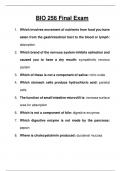
-
BIO 256 Final Exam 2023
- Exam (elaborations) • 10 pages • 2023
-
- $9.99
- + learn more
BIO 256 Final Exam 2023 BIO 256 Final Exam 1. Which involves movement of nutrients from food you have eaten from the gastrintestinal tract to the blood or lymph: absorption 2. Which brand of the nervous system inhibits salivation and caused you to have a dry mouth: sympathetic nervous system 3. Which of these is not a component of saliva: nitric oxide 4. Which stomach cells produce hydrochloric acid: parietal cells 5. The function of small intestine microvilli is: increas...
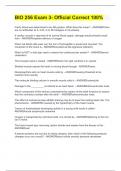
-
BIO 256 Exam 3- Official Correct 100%
- Exam (elaborations) • 8 pages • 2024
-
- $10.99
- + learn more
Fred's blood was determined to be AB positive. What does this mean? - ANSWERThere are no antibodies to A, to B, or to RH antigens in his plasma If cardiac muscle is deprived of its normal blood supply, damage would primarily result from - ANSWERimpaired delivery of oxygen
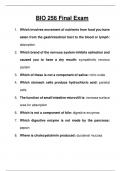
-
BIO 256 Final Exam 2023
- Exam (elaborations) • 10 pages • 2023
-
- $10.99
- + learn more
BIO 256 Final Exam 1. Which involves movement of nutrients from food you have eaten from the gastrintestinal tract to the blood or lymph: absorption 2. Which brand of the nervous system inhibits salivation and caused you to have a dry mouth: sympathetic nervous system 3. Which of these is not a component of saliva: nitric oxide 4. Which stomach cells produce hydrochloric acid: parietal cells 5. The function of small intestine microvilli is: increase surface area for absorpt...
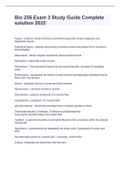
-
Bio 256 Exam 3 Study Guide Complete solution 2022.
- Exam (elaborations) • 11 pages • 2022
- Available in package deal
-
- $11.49
- + learn more
Bio 256 Exam 3 Study Guide Complete solution 2022.
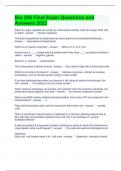
-
Bio 256 Final Exam Questions and Answers 2023
- Exam (elaborations) • 10 pages • 2023
-
Available in package deal
-
- $20.99
- + learn more
Bio 256 Final Exam Questions and Answers 2023 When an organ regulates its activity by mechanisms entirely within the organ itself, this is called intrinsic regulation This fluid compartment is subdivided into blood plasma and interstitial fluid/lymph. extracellular compartments Which is an organic molecule? DNA or H-C, O-C, N-C Anions have a ____ charge and are formed when they have ____ an electron to/from a cation. negative, gained Starch is a carbohydrate ...
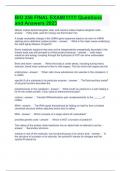
-
BIO 256 FINAL EXAM!!!!!!!! Questions and Answers 2023
- Exam (elaborations) • 62 pages • 2023
-
Available in package deal
-
- $24.99
- + learn more
BIO 256 FINAL EXAM!!!!!!!! Questions and Answers 2023 Mitosis makes diploid daughter cells, and meiosis makes haploid daughter cells. Fatty acids used for energy are first broken into A single nucleotide change in the LMNA gene sequence leads to an error in mRNA splicing and a defective nuclear protein. What is the major cause underlying the rapid aging disease, Progeria? Some metabolic reactions that may not be independently energetically favorable in the human body may still p...
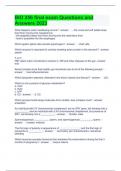
-
BIO 256 final exam Questions and Answers 2023
- Exam (elaborations) • 7 pages • 2023
-
Available in package deal
-
- $18.49
- + learn more
BIO 256 final exam Questions and Answers 2023 What happens when swallowing occurs? - the uvula and soft palate keep food from moving into nasopharynx - the epiglottis keeps food from moving into the respiratory tract - food is propelled into the esophagus Which gastric gland cells secrete pepsinogen? chief cells Which enzyme is important for actively breaking down protein in the stomach? pepsin T or F: FMT alters colon microbiota to resolve C. Diff and other diseases ...

That summary you just bought made someone very happy. Also get paid weekly? Sell your study resources on Stuvia! Discover all about earning on Stuvia


